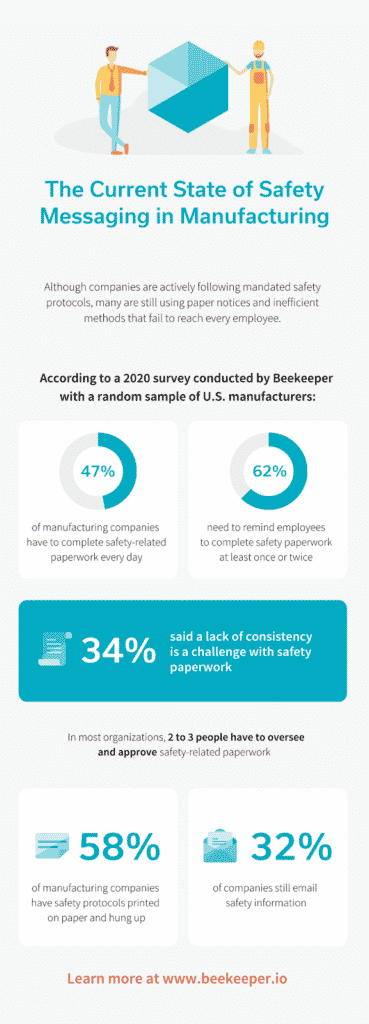Productivity is a word we hear a lot when it comes to running a business, and for good reason. It can make or break a company’s chances of success. Finding ways to increase productivity in manufacturing comes down to building a thriving workforce and adopting technology that speeds up production and creates a safer workplace.
Leaders need to set the stage for productivity by creating a digitally-led culture that takes a bottom-up leadership approach. Employee talent is a critical asset for any company, and it has to be maximized by ensuring employees are motivated to work and deliver great results they are capable of and qualified for.
Manufacturing employers must integrate digital tools to enhance the productivity and efficiency of their workforce. A very successful plant manager once stated that one of the keys to becoming a thriving manufacturing company is to do simple things remarkably well. This means that great results can actually come from mastering simple techniques and applying them consistently. (For more on this, look at the section below on lean operations.)
Why It’s Important to Find Ways to Increase Productivity In Manufacturing
Before COVID-19 disrupted global supply chains, demand for goods was on a steady incline. As markets stabilize and companies move into the next normal, increasing productivity and operational efficiency is essential to compete on a global scale once again.
Being a more productive organization is a byproduct of deliberate business strategies, like adopting lean operation management, automating repetitive tasks (both production and administrative,) and using digital tools for internal communication.
Here are ten powerful ways to increase productivity in manufacturing.
1. Provide Easy Access to Digital Communication Tools

As a company leader in your manufacturing business, you are often faced with difficult choices. When it comes to improving your off-site or non-desk workers, you can either just watch your competitors become more efficient or give your staff the means to work effectively from any location.
Giving your workers access to systems they need to perform well is one of the secrets to increase productivity in manufacturing. This can be done by integrating cloud services or mobile solutions to enhance their efficiency on the production line or from outside the workplace. This makes information remotely accessible for them, enhancing their work-life balance.
2. Embrace AI
The most successful manufacturing companies across all industries leverage technology to give their workers easy access to communications, collaboration, and information even when they are off-site. Companies should embrace AI as a mechanism for improving productivity and a technological asset to their schedules, deadlines, and workforce productivity
With the help of AI-assisted manufacturing technology, workers (including remote workers) can get the most up-to-date analytics information in real time to adjust production timeframes or schedule equipment maintenance accordingly. This gives them mobility, and more of the information they need when they need it, which empowers them to get more done in a shorter amount of time. This will also ease workload, reduce time-wasting actions, and amplify productivity.
3. Have a Mobile Operational Communication Strategy in Place
Internal mobile communication can do more than just manage and distribute information. Quality internal communication strategies can cultivate the development of a community between the workers and employers that will foster a relationship of trust, which is vital to a team working towards achieving a goal.
Internal communication strategies are a vital component of any business, especially for employees on the frontlines. Just as mobile devices transformed the way we operate in our personal lives, business mobility can also be revolutionary. Since most don’t non-desk workers don’t have access to email, these apps provide a solution for them to keep in regular contact with the whole company.
Mobile operational communication increases productivity in manufacturing by:
- Creating a single portal for systems and data within an organization for enterprise-wide access, and where employees can have all their tools in one simple interface
- Breaking down hierarchies and information silos for fluid, real-time communication, effective collaboration, and faster problem solving
- Enabling frontline production workers to contribute valuable insight and ideas for greater innovation
4. Invest in Continued Manufacturing Workforce Education
AI, VR, AR, cobots. Industry 4.0 is here. The operational technology that’s emerging is changing the way companies are machining, cutting, and manufacturing goods for faster, safer, more efficient productivity.
These advancements mean the workforce needs a different set of skills to work in an IoT ecosystem. With a mobile communication tool, companies can upskill their current workers with education and regular training to level up and keep pace with smart machines. It’s worth noting that these new jobs create deeper employee engagement as workers are removed from repetitive production lines and given more autonomy through more cerebral positions.
5. Make Safety a Digital Communication Priority
As companies embrace all things digital, it’s important to transfer your safety messaging to your new systems. You’d be surprised how easy it is to ensure every employee has seen vital messaging. You’ll even see faster return rates on safety forms that need to be signed once you do away with paper forms and switch to a workforce app.
A mobile tool can have a read receipt feature, like Beekeeper’s confirmation campaign, to track exactly which employees have read messages, and who you need to follow up with. For an industry with one of the highest workplace injury records, a mobile communication tool can reduce workplace incidents which means continuous workflows for greater productivity.

6. Recruit and Build a Diverse Workforce
It’s no secret that manufacturing has been facing a growing labor shortage and a widening skills gap. There are two primary causal factors:
- More than a quarter of the workforce is over 55 and reaching retirement age
- Millennials and Generation Z are not considering careers in manufacturing
Companies need to design new hiring strategies, especially to attract from a more diverse talent pool. For example, employers should aim recruitment efforts toward women earning engineering degrees at educational institutions.
Not only will this fill jobs and boost the manufacturing workforce for better production capabilities, but a greater diversity of voices and opinions creates a more innovative company with a greater number of product offerings.
7. Use Digital Tools To Store Institutional Knowledge
Another major downside to a retiring workforce is brain drain—the institutional knowledge that leaves with them. It can lead to disrupted operation schedules and dramatically slow production as managers need to duct tape together the broken information stream. In other words, they have to make do with less information and get new workers up to speed on how to do things which has a domino effect of slowing everything down.

With a digital platform that integrates systems and data, the knowledge stays on site rather than evaporating when workers retire or switch jobs, enabling business continuity and uninterrupted workflows.
8. Encourage Mobile Collaboration for Better Team Productivity
A company becomes more productive when everyone works together towards achieving a similar goal with minimal conflict and confusion, which are substantial time wasters. Effective collaboration is easy when you share a work location or office. But with a company that relies on frontline employees working on multiple production lines, facilitating collaboration may be a challenge
This is where the implementation of a quality mobile collaboration solution comes in. Connecting every worker on one communication portal allows colleagues to work together and results in greater growth and innovation. Your manufacturing company can integrate a system that features collaborative elements that will change the way teams work together and enhance team productivity.
9. Have a Crisis Communication Strategy Ready
You’d be hard pressed to find a company who has not felt the deep impact of COVID-19. Manufacturing took a severe blow, experiencing a 10% plummet in demand in April alone. With little warning, production lines came to a halt in many companies.
Being prepared for any crisis that can disrupt operations is essential to your company’s survival. That means equipping your team with the right tools to keep things moving even during a major disruption like a global pandemic.
Business continuity and crisis communication strategies should include:
- Digital tools to automate systems that can keep performing tasks when humans can’t be there
- A mobile communication tool accompanied by a detailed content strategy for coordinating workflows and your workforce when a crisis hits
- Appointing a crisis management team to keep workers calm during an ambiguous time and workflows running smoothly for continued productivity
10. Go Lean
If your company hasn’t been considering a lean operations approach, now is the time. The basic premise is improving your operational efficiency to eliminate waste, reduce costs, and boost productivity. Lean companies use strategies like reducing on-site inventory to save on overhead and use a digital workplace as a communication hub so everyone can communicate in real time and access company information as they need it.
Going lean can reduce the impact of any disruptions. For example, that 10% decrease in manufacturing demand that happened due to COVID-19? A lean approach creates a more agile and resilient organization, able to absorb a blow like that and almost seamlessly pivot strategies to survive.
As the industry moves into the next normal and back to a regular rhythm of production, companies should take advantage of the different ways to increase productivity in manufacturing. Not only will this improve their odds of surviving the next crisis, it will support a thriving workforce and a more favorable spot in the manufacturing line up.
Most Frequently Asked Questions
What are ways to improve production?
1. Provide Easy Access to Digital Communication Tools
2. Embrace AI
3. Have a Mobile Operational Communication Strategy in Place
4. Invest in Continued Manufacturing Workforce Education
5. Make Safety a Digital Communication Priority
6. Recruit and Build a Diverse Workforce
7. Use Digital Tools To Store Institutional Knowledge
8. Encourage Mobile Collaboration for Better Team Productivity
9. Have a Crisis Communication Strategy Ready
10. Go Lean

About the author
Beekeeper
We make frontline lives easier, work safer, and teams more connected so businesses can reach new heights. At Beekeeper, we’re dedicated to making frontline lives easier by connecting workers with the tools, support, and information they need to feel valued, do their best work, and drive the business forward.








